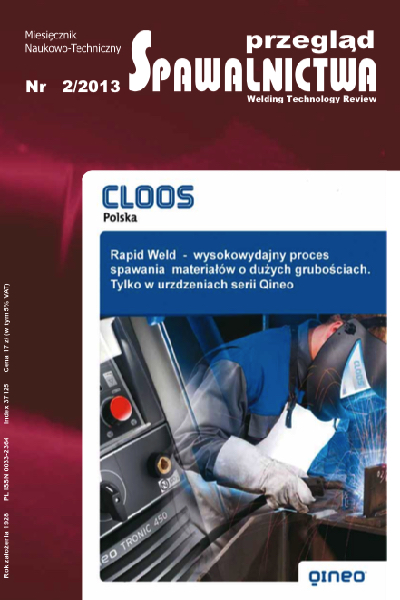Charakter pękania połączeń spawanych stali 7CrMoVTiB10-10 (T24)
Main Article Content
Abstract
W artykule omówiono pękanie połączeń spawanych stali 7CrMoVTiB10-10 (T24), stosowanej na ściany szczelne w kotłach energetycznych, pracujących przy parametrach nadkrytycznych. Jednym z powodów pękania, ze względu na mikrostrukturę materiału spawanego, może być negatywne oddziaływanie wodoru, zarówno podczas spawania, jak i eksploatacji. Stosowanie obróbki cieplnej po spawaniu poprawia właściwości plastyczne złączy, ale może wywoływać również pękanie relaksacyjne.
Character of fracture of welded joints of 7crMoVtiB10-10 (T24) steel
Abstract
The paper presents the character of fracture of welded joints of 7CrMoVTiB10-10 (T24) steel, used to the membrane walls in power plants boilers operating at supercritical conditions. The cause for the cracking, due to the microstructure of the welded metal, is negative effects of hydrogen content, both during welding and exploitation. Post weld heat treatment improves the plastic properties of joints, but can also cause reheat cracking.
Downloads
Article Details
Creative Commons CC BY 4.0 https://creativecommons.org/licenses/by/4.0/
Welding Technology Review (WTR) articles are published open access under a CC BY licence (Creative Commons Attribution 4.0 International licence). The CC BY licence is the most open licence available and considered the industry 'gold standard' for open access; it is also preferred by many funders. This licence allows readers to copy and redistribute the material in any medium or format, and to alter, transform, or build upon the material, including for commercial use, providing the original author is credited.
References
Bendick W., Gabrel J., Hahn B., Vandenberghe B.: New low alloy heat resistant ferritic steels T/P23 and T/P24 for power plant application, International Journal of Pressure Vessels and Piping, 2007, nr 84, s. 13-20.
PN-EN 10216-2:2009, Rury stalowe bez szwu do zastosowań ciśnieniowych Warunki techniczne dostawy Część 2: Rury ze stali niestopowych i stopowych z określonymi właściwościami w temperaturze podwyższonej,
Heuser H., Jochum C.: Alloy design for similar and dissimilar welding and their behaviours [w:] 1st International Conference Super-High Strenght Steels, Rome-Italy, 2-4 november 2005.
Adamiec J.: Hot cracking of welded joints of the 7CrMoVTiB 10-10 (T/P24) steel, IOP Conference Series: Materials Science and Engineering 22 Technologies and Properties of Modern Utilised Materials, 2011.
Gawrysiuk W., Więcek M., Adamiec J.: Spawanie ścian szczelnych wykonanych ze stali T/P24 (7CrMoVTiB10-10). Fakty i Mity, Spawanie w energetyce: XVII międzynarodowa konferencja Opole-Turawa 20-23 kwietnia 2010, Wydawnictwo Instytut Śląski, Opole 2010, s. 82-87.
Mohyla P., Koukal J.: Contribution to research of weldability of modern low-alloy creep resistant steels, Acta Metallurgica Slovaca, 2003, nr 9, s. 210-216.
Nevasmaa P., Laukknaen A.: Procedure for the Prevention of Hydrogen Cracking in Multipass Weld Metal with Emphasis on the Assessment of Cracking Risk in 2.25Cr-1Mo-0.25V- TiB (T24) Boiler Steel, Document IX-2131-04 for the 57th an- nual assembly of the international institute of welding (IIW), Osaka, Japan, 11-16 July 2004.
Tasak E., Ziewiec A., Parzych S.: Wpływ obróbki cieplnej na właściwości złącz spawanych wykonanych łukiem krytym i metodą GTAW w stali 7CrMoVTiB10-10, Powerwelding 2011: II konferencja spawalnicza: badania oraz zastosowanie nowych stali żarowytrzymałych dla energetyki w zakresie temperatury pracy 600-650°C, Kroczyce, Ostaniec 8-9 wrzesień 2011, s. 179-188.
Pańcikiewicz K., Kwiecień S., Tasak E.: Właściwości połączeń spawanych stali 7CrMoVTiB10-10 (T24) po obróbce cieplnej, Przegląd Spawalnictwa, R. 84, nr 1, 2012, s. 15-17.
Tasak E., Ziewiec A., Adamiec J.: Wpływ wodoru na pękanie spoin w stalach bainitycznych i mikrostopowych, Hutnik Wiadomości Hutnicze, R. 75, nr 4, 2008, s. 170-176.
